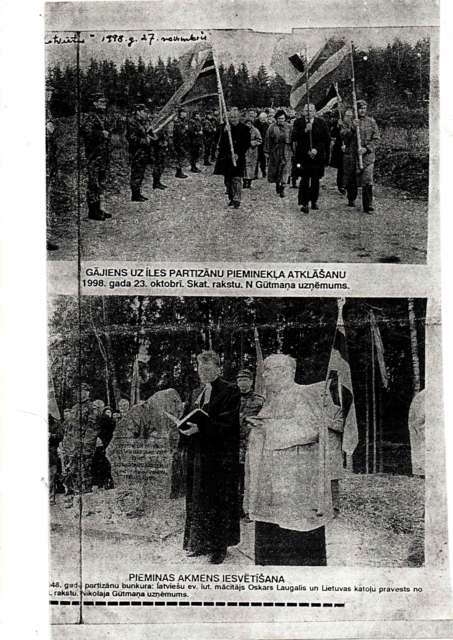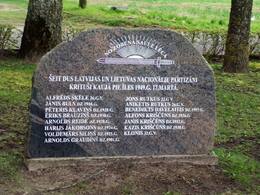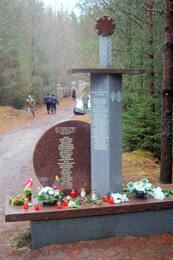Visvalžas Brizga (Kārļa krauja) National Partisan Group

The Īle "Kārļa Krauja" Latvian and Lithuanian joint national partisan group was one of the largest resistance groups in the territory of Latvia in the period from 1947 to 1949.
The “Kārļa Krauja” national partisan group was formed in 1947, from persons serving in the Latvian Legion, from persons who had avoided service in the Soviet Army, or persons who had been forced to join the aforementioned group for other reasons. The group’s commander was Visvaldis Žanis Brizga. In October 1948, the “Kārļa Krauja” group merged with the Lithuanian national partisan group, which was commanded by the group commander with the nickname “Bize”. The group operated in the vicinity of Zebrene, Auce, Biksti, Slagūna, Naudīte and Īle in Jelgava County. The group consisted of about 30 national partisan members. In October 1948, in Lielauce parish, near Īle forestry, the group built a closed, well-camouflaged underground bunker measuring 9 x 6 m, with two exits, and mined the area with remote-controlled mines. In terms of size, this was the largest national partisan bunker in Latvia. During the existence of the group, about 20 anti-Soviet actions were carried out. On March 17, 1949, troops of the Latvian SSR Ministry of State Security surrounded the bunker of the “Kārļa Krauja” group in the forest massif of Auce parish, Jelgava district, 300 meters north of the “Priedaiši” houses. The attack on the “Kārļa Krauja” group was carefully planned and already approved on March 11, 1949. As evidenced by the attack plan approved by the commander of the 5th Division of the Internal Troops of the USSR Ministry of State Security (VDM) Major General P. Ļeontjev on March 16, 1949, a unit of 760 VDM soldiers participated in it, which included 261 of the VDM 5th Division deployed in the territory of Latvia; Soldiers and officers of the 36th and 32nd regiments, of which 600 were in the blocking group, 120 in the reconnaissance group, and 40 in the reserve group. The VDM troops arrived in the attack area on March 17, 1949 at 5:00 a.m., in 35 trucks. First, a blockade operation was carried out in the area. The reconnaissance group arrived at the starting position at 7:30 a.m., the attack began at 8:00 a.m. At around 9:00 a.m. a strike group of 120 people discovered a well-camouflaged bunker, the length of the passages of which reached 45 m, the surroundings within a radius of 15-20 m were mined with remote-controlled mines. When the strike group discovered the bunker and approached it, 24 members of the joint Latvian-Lithuanian national partisan group were in the bunker together with a guard post. The previous evening, 3 members of the group, commander Visvaldis Brizga, Juris Krusts and Reinis Hercs, had left the bunker. The national partisans in the bunker started the battle from both exit hatches and detonated 42 mines, the remaining 28 mines were neutralized by sappers during the attack. As a result of the five-hour battle, by blowing up the bunker cover in 2 places, the attackers managed to force the surviving national partisans to surrender by throwing hand grenades into the bunker and trying to set it on fire. After the battle, 9 members of the group were arrested (7 Latvians and 2 Lithuanians), but 15 fell during the battle (8 Latvians and 7 Lithuanians), some of whom shot themselves. Attackers' losses: lightly wounded - 2, seriously wounded - 2, and died from their injuries - 2 VDM soldiers.
https://www.historia.lv/video/iles-bunkurs-1949g-17marta-kaujas-rekonstrukcija
https://www.lvm.lv/jaunumi/2460-nacionalo-partizanu-bunkurs-iles-mezos
Zihmanis.M. There in the forest, in a small bunker//I put it on a hedgehog's head., Riga, 1993
Bajārs.V. He was one of the most terrifying.//Latvijas avīze., April 18, 2006;
Strods.H. Latvian National Partisan War III., Riga., 2003,
Strods.H. Latvian National Partisan War II., Riga.1999.,
Strods.H. The Latvian National Partisan War I., Riga.1996.,
Related topics
Related objects
The Brothers' Cemetery of the Īle National Partisans in the Virkus Cemetery, Bērze Parish
The Īle National Partisan Brothers' Cemetery in the Virkus cemetery of Bērze parish was established on November 14, 1992, when 15 partisans who fell in the Battle of Īle on March 17, 1949, were buried here. This was possible after on July 18, 1992, the National Guard, together with the organization "Daugavas Vanagi" and the Latvian history research working group "Ziemeļblāzma", with the participation of representatives of other nationally-minded organizations, exhumed the remains of 15 Latvian and Lithuanian forest brothers buried in a blown-up partisan bunker in the Īle forest district of Zebrene parish.
The memorial stone to the national partisans who fell in the Battle of Īle was unveiled on May 29, 1993. It was designed by Alfons Kalniņš ("Edgars"), one of the surviving participants in the battle of March 17, 1949. The regular-shaped granite slab depicts a sword and a rising sun, and is engraved with the names of 15 fallen national partisans and the inscription:
“The sun rose from the sword. Here lie the Latvian and Lithuanian national partisans who fell in the battle of Īle on March 17, 1949.”
Īle National Partisan Bunker
The bunker is located in the Īle forestry of Zebrene Rural Territory, at the turn-off from the P104 Biksti-Auce Road.
The Kārlis Krauja Group of Īle National Partisans was formed in 1947. V. Z. Brizga (alias K. Krauja) was appointed the commander of the group. In October 1948, the Krauja Group merged with a group of Lithuanian national partisans. Krauja Group operated in Jelgava District and consisted of 27 national partisans.
In October 1948, Krauja Group built an underground bunker in Lielauce Parish, Jelgava County, not far from the Īle Forestry, 300 metres to the north of the “Priedaišu” house. Its total length, including battle passages, was 45 metres. 70 remote-controlled mines were planted around the bunker. The bunker was equipped with a furnace, a well, a toilet, and a storage room.
On 17 March 1949, the 24 partisans who were in the bunker at the time fought their last battle against the 760-strong troops of the Ministry of National Security or Cheka. After the battle, 9 members of the group were arrested, while 15 fell in the battle, with eight of them being Latvian and seven being Lithuanian. In 1992, the Home Guards, together with the Daugavas Vanagi (Hawks of the Daugava), unearthed the bunker that had been blown up. A White Cross, a memorial stone and a granite statue were erected at the site.
Inside the bunker, you can see a stove, a table, and narrow benches on which the partisans slept. Information boards and memorial stones with the names of the partisans have been installed at the bunker.








